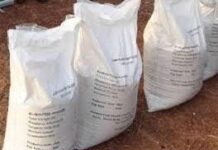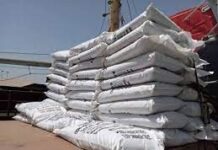with Abdoulie Dibba
This column is devoted to monitor and report on issues that relate to food  security in the Gambia as well as the interventions of Government and Non-governmental Organizations.
Farmers’ Eye has being touring the country talking the farming communities regarding their constraints and the way forward in ensuring food security in the Gambia. They have repeatedly said that there cannot be food security in the Gambia without increased productivity and there cannot be increased productivity in the absent of farm implements, fertilizer and enough water for the crops”.
In his address to the National Assembly in 2012, the President indicated that his Government through the Ministry of Agriculture and in collaboration with the Taiwanese Agricultural Mission, were putting under rice cultivation about 400,000 hectares of land over a period of five years, a process that has started since the year 2009. The objective, he said, is that even with an output/yield of one tonne of rice per hectare, once the entire four hundred thousand hectares are put under rice cultivation, we would produced more than what we consume and can go into the export Market.
Farmers’ Eye has started visiting the rice farms and will be featuring the current state of farming.
However, in this edition, we will refresh the mind of our readers on the interventions taken with regard to rice production in The Gambia.
For the information of the readers, the first major intervention in rice production in the Gambia is pump irrigation and the first pump irrigation scheme in The Gambia was initiated by the Colonial Development Cooperation ( CDC) Rice Project which, in 1953, developed 1,050 Ha in Jahally swamps for double cropping rice (wet and dry season).
This project provided irrigation structures and machinery for pump irrigation and mechanized f arming.
The Colonial Development Cooperation (CDC) Rice project was followed in 1968 by the Taiwanese Mission rice project. This project was a labour intensive smallholder scheme in which Land preparation was manually done by farmers who were provided free inputs for one year. The farmers were then expected to pay for their inputs after the one year.
The project ended developing 1,200 Ha covering 193 villages in Central and Upper River Divisions.
In 1973, a World Bank IDA Financed Agricultural Development Project (ADP) was launched in Central River Region (CR R) to develop 200 Ha. The project improved the perimeter design to include drainage system and allow irrigation of individual plots with input credit for farmers. Up to 500 Ha were developed by the project.
The World Bank IDA Financed Agricultural Development Project was followed in 1976 by a project implemented by the Agro Technical Team of the Peoples ‘ Republic of China. The Team was to develop 1,000 to 1,200 Ha of small holder rice irrigation schemes, consolidate 800 Ha of existing schemes of past interventions, and initiate a pilot scheme to improve the Pacharr swamps.
By 1980, about 2,600 Ha in CRR, and URR were developed and put under irrigation.
The Jahally-Pacharr Smallholder Project had a 560 Ha pump irrigated area out of the developed 1,510 Ha rice production schemes. Unlike the small perimeter schemes, the Jahally-Pacharr schemes were designed with a complete network of irrigation and drainage channels. These centrally managed irrigation schemes had average yields of 5 – 6 tonnes per Ha.
Under the Rice Development Project (RIDEP), about 350 Ha of pump irrigated perimeters were reconstructed in south CRR. The exercise involved a re-design of the perimeters, land clearing and levelling, construction of access roads and a bridge, the provision of a pumping station and construction of concrete-lined canals for adequate water control and conveyance system.
See part two]]>
security in the Gambia as well as the interventions of Government and Non-governmental Organizations.
Farmers’ Eye has being touring the country talking the farming communities regarding their constraints and the way forward in ensuring food security in the Gambia. They have repeatedly said that there cannot be food security in the Gambia without increased productivity and there cannot be increased productivity in the absent of farm implements, fertilizer and enough water for the crops”.
In his address to the National Assembly in 2012, the President indicated that his Government through the Ministry of Agriculture and in collaboration with the Taiwanese Agricultural Mission, were putting under rice cultivation about 400,000 hectares of land over a period of five years, a process that has started since the year 2009. The objective, he said, is that even with an output/yield of one tonne of rice per hectare, once the entire four hundred thousand hectares are put under rice cultivation, we would produced more than what we consume and can go into the export Market.
Farmers’ Eye has started visiting the rice farms and will be featuring the current state of farming.
However, in this edition, we will refresh the mind of our readers on the interventions taken with regard to rice production in The Gambia.
For the information of the readers, the first major intervention in rice production in the Gambia is pump irrigation and the first pump irrigation scheme in The Gambia was initiated by the Colonial Development Cooperation ( CDC) Rice Project which, in 1953, developed 1,050 Ha in Jahally swamps for double cropping rice (wet and dry season).
This project provided irrigation structures and machinery for pump irrigation and mechanized f arming.
The Colonial Development Cooperation (CDC) Rice project was followed in 1968 by the Taiwanese Mission rice project. This project was a labour intensive smallholder scheme in which Land preparation was manually done by farmers who were provided free inputs for one year. The farmers were then expected to pay for their inputs after the one year.
The project ended developing 1,200 Ha covering 193 villages in Central and Upper River Divisions.
In 1973, a World Bank IDA Financed Agricultural Development Project (ADP) was launched in Central River Region (CR R) to develop 200 Ha. The project improved the perimeter design to include drainage system and allow irrigation of individual plots with input credit for farmers. Up to 500 Ha were developed by the project.
The World Bank IDA Financed Agricultural Development Project was followed in 1976 by a project implemented by the Agro Technical Team of the Peoples ‘ Republic of China. The Team was to develop 1,000 to 1,200 Ha of small holder rice irrigation schemes, consolidate 800 Ha of existing schemes of past interventions, and initiate a pilot scheme to improve the Pacharr swamps.
By 1980, about 2,600 Ha in CRR, and URR were developed and put under irrigation.
The Jahally-Pacharr Smallholder Project had a 560 Ha pump irrigated area out of the developed 1,510 Ha rice production schemes. Unlike the small perimeter schemes, the Jahally-Pacharr schemes were designed with a complete network of irrigation and drainage channels. These centrally managed irrigation schemes had average yields of 5 – 6 tonnes per Ha.
Under the Rice Development Project (RIDEP), about 350 Ha of pump irrigated perimeters were reconstructed in south CRR. The exercise involved a re-design of the perimeters, land clearing and levelling, construction of access roads and a bridge, the provision of a pumping station and construction of concrete-lined canals for adequate water control and conveyance system.
See part two]]>




















